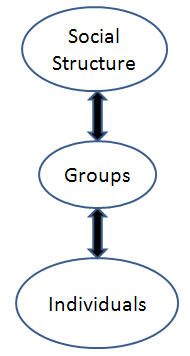Durkheim and Anomie � The Social Lens
Anomie is one of those concepts in the field of Sociology that can be applied in a variety of ways. Coined by French Sociologist Emile Durkheim in his 1897 study “Suicide”, anomie refers to a sense of normlessness, resulting in individual detachment and disconnection from other members of a group or society at large.
Sociologists see society as an organism, much the way the human body is an organism. Society, just like the human body, is a sum of its parts.
Staying with the human anatomy and physiology theme, I like to think of the above image as the “skeleton” of society. Below you’ll find the makeup of the “central nervous system”. These are the fundamental elements of culture.
Keep in mind that norms are the guidelines and expectations in society. They are not right or wrong, but we as members of society determine at any given moment in time or history the makeup of norms. For example, it once was the norm for males to hold the door open for females. That is a particular folkway that seems to not carry as much importance in relationships anymore. Norms, just like culture, change. The “skeleton” of society, and the “central nervous system”, remain the same.
This is the stuff that theory is made of, and precisely the insight that Durkheim was seeking to provide in his study on suicide, and his coining of the term anomie. Individuals that feel connected to the prevailing cultural norms, to groups, to society as a whole, engage in conventional behavior and have more in common with others in the group or community. Some would suggest that those that feel more connected also have a more positive sense of self or self concept. When people feel detached, when they feel that they do not belong, this is anomie. What groups or individuals in society are seen as detached or disconnected?
In order to understand anomie one has to understand not only how society and culture is organized, but also the subjective nature of society and culture. Therefore anomie, just like society and culture, changes. This poses a challenge to members of society; the need to change, to adapt, to fit in. Structural functionalists would say that social institutions play an important role in this regard of keeping society organized and efficient, that members of society feel included. Social conflict theorists may suggest that anomie is a byproduct of society; that varied access to resources inherently breeds anomie in society, thereby leading to constant inequality and social change.
Can you think of other examples of anomie? Do you feel that you are connected to the prevailing social norms? Do you feel that most people in your community have a sense of anomie or feel like they belong in the community? How does sense of connection change over the life span? What can members of social institutions and organizations do to make sure people feel included and connected?


No comments:
Post a Comment